Organizational Change Management: Telespazio Performance Appraisal
VerifiedAdded on 2023/06/04
|6
|2191
|349
Case Study
AI Summary
This case study examines Telespazio's organizational change management as it transitions into a matrix organization, focusing on the company's performance appraisal system and HR strategies. It discusses whether a double-rater system should be adopted or if responsibility for performance appraisal should be given to a single supervisor, weighing the advantages and disadvantages of each approach. The case highlights the HR team's concerns regarding equity and selectivity in managers' evaluations and suggests actions to improve managers' rating skills. Furthermore, it explores Telespazio's plans to transfer the appraisal system to its foreign subsidiaries, recommending strategies such as ethnocentric and polycentric approaches to facilitate this process. The analysis covers various aspects of change management, including the implementation of new appraisal schemes, addressing delays, equity issues, and the importance of training and communication within the organization. The document is available on Desklib, a platform offering a wide range of study resources for students.
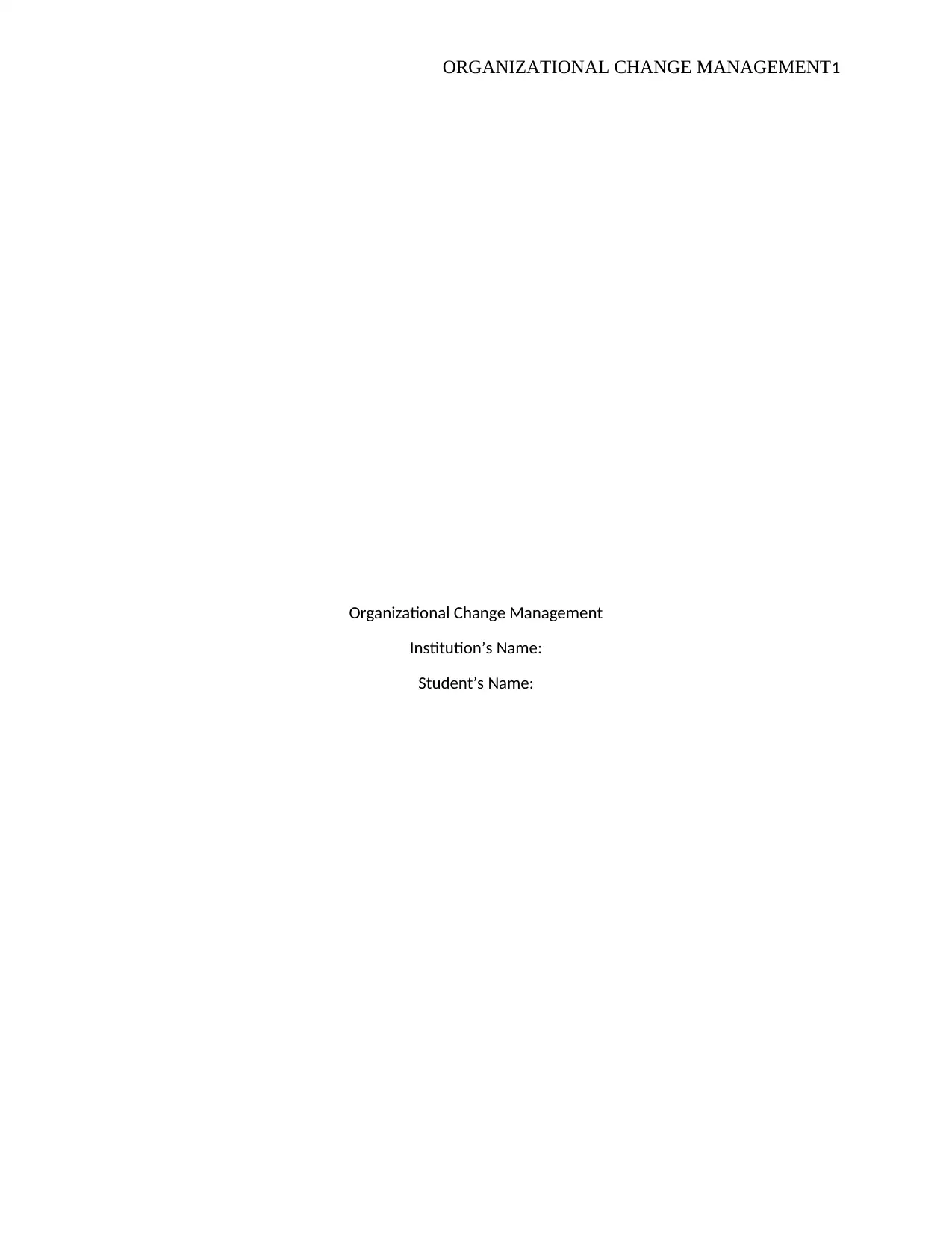
ORGANIZATIONAL CHANGE MANAGEMENT1
Organizational Change Management
Institution’s Name:
Student’s Name:
Organizational Change Management
Institution’s Name:
Student’s Name:
Paraphrase This Document
Need a fresh take? Get an instant paraphrase of this document with our AI Paraphraser
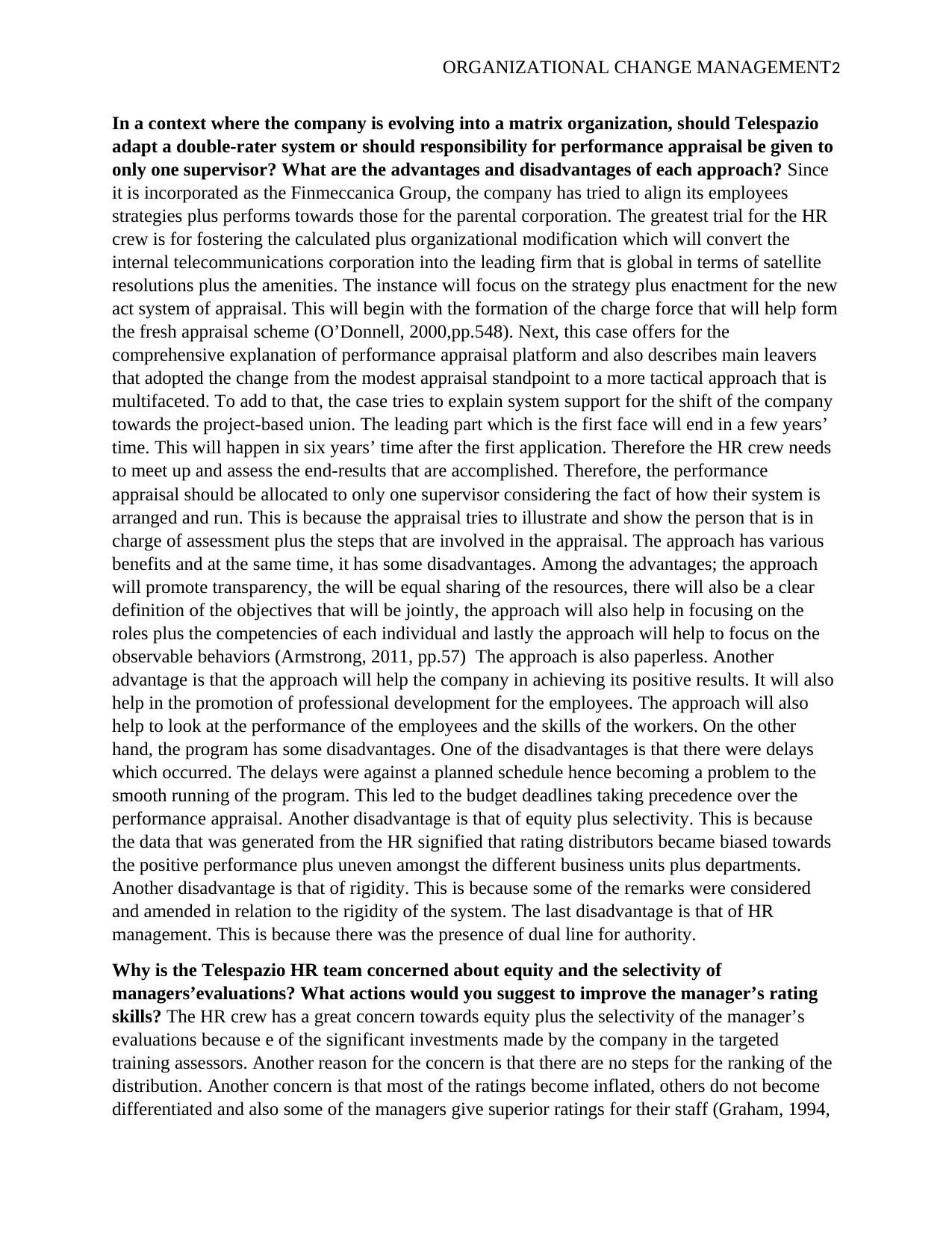
ORGANIZATIONAL CHANGE MANAGEMENT2
In a context where the company is evolving into a matrix organization, should Telespazio
adapt a double-rater system or should responsibility for performance appraisal be given to
only one supervisor? What are the advantages and disadvantages of each approach? Since
it is incorporated as the Finmeccanica Group, the company has tried to align its employees
strategies plus performs towards those for the parental corporation. The greatest trial for the HR
crew is for fostering the calculated plus organizational modification which will convert the
internal telecommunications corporation into the leading firm that is global in terms of satellite
resolutions plus the amenities. The instance will focus on the strategy plus enactment for the new
act system of appraisal. This will begin with the formation of the charge force that will help form
the fresh appraisal scheme (O’Donnell, 2000,pp.548). Next, this case offers for the
comprehensive explanation of performance appraisal platform and also describes main leavers
that adopted the change from the modest appraisal standpoint to a more tactical approach that is
multifaceted. To add to that, the case tries to explain system support for the shift of the company
towards the project-based union. The leading part which is the first face will end in a few years’
time. This will happen in six years’ time after the first application. Therefore the HR crew needs
to meet up and assess the end-results that are accomplished. Therefore, the performance
appraisal should be allocated to only one supervisor considering the fact of how their system is
arranged and run. This is because the appraisal tries to illustrate and show the person that is in
charge of assessment plus the steps that are involved in the appraisal. The approach has various
benefits and at the same time, it has some disadvantages. Among the advantages; the approach
will promote transparency, the will be equal sharing of the resources, there will also be a clear
definition of the objectives that will be jointly, the approach will also help in focusing on the
roles plus the competencies of each individual and lastly the approach will help to focus on the
observable behaviors (Armstrong, 2011, pp.57) The approach is also paperless. Another
advantage is that the approach will help the company in achieving its positive results. It will also
help in the promotion of professional development for the employees. The approach will also
help to look at the performance of the employees and the skills of the workers. On the other
hand, the program has some disadvantages. One of the disadvantages is that there were delays
which occurred. The delays were against a planned schedule hence becoming a problem to the
smooth running of the program. This led to the budget deadlines taking precedence over the
performance appraisal. Another disadvantage is that of equity plus selectivity. This is because
the data that was generated from the HR signified that rating distributors became biased towards
the positive performance plus uneven amongst the different business units plus departments.
Another disadvantage is that of rigidity. This is because some of the remarks were considered
and amended in relation to the rigidity of the system. The last disadvantage is that of HR
management. This is because there was the presence of dual line for authority.
Why is the Telespazio HR team concerned about equity and the selectivity of
managers’evaluations? What actions would you suggest to improve the manager’s rating
skills? The HR crew has a great concern towards equity plus the selectivity of the manager’s
evaluations because e of the significant investments made by the company in the targeted
training assessors. Another reason for the concern is that there are no steps for the ranking of the
distribution. Another concern is that most of the ratings become inflated, others do not become
differentiated and also some of the managers give superior ratings for their staff (Graham, 1994,
In a context where the company is evolving into a matrix organization, should Telespazio
adapt a double-rater system or should responsibility for performance appraisal be given to
only one supervisor? What are the advantages and disadvantages of each approach? Since
it is incorporated as the Finmeccanica Group, the company has tried to align its employees
strategies plus performs towards those for the parental corporation. The greatest trial for the HR
crew is for fostering the calculated plus organizational modification which will convert the
internal telecommunications corporation into the leading firm that is global in terms of satellite
resolutions plus the amenities. The instance will focus on the strategy plus enactment for the new
act system of appraisal. This will begin with the formation of the charge force that will help form
the fresh appraisal scheme (O’Donnell, 2000,pp.548). Next, this case offers for the
comprehensive explanation of performance appraisal platform and also describes main leavers
that adopted the change from the modest appraisal standpoint to a more tactical approach that is
multifaceted. To add to that, the case tries to explain system support for the shift of the company
towards the project-based union. The leading part which is the first face will end in a few years’
time. This will happen in six years’ time after the first application. Therefore the HR crew needs
to meet up and assess the end-results that are accomplished. Therefore, the performance
appraisal should be allocated to only one supervisor considering the fact of how their system is
arranged and run. This is because the appraisal tries to illustrate and show the person that is in
charge of assessment plus the steps that are involved in the appraisal. The approach has various
benefits and at the same time, it has some disadvantages. Among the advantages; the approach
will promote transparency, the will be equal sharing of the resources, there will also be a clear
definition of the objectives that will be jointly, the approach will also help in focusing on the
roles plus the competencies of each individual and lastly the approach will help to focus on the
observable behaviors (Armstrong, 2011, pp.57) The approach is also paperless. Another
advantage is that the approach will help the company in achieving its positive results. It will also
help in the promotion of professional development for the employees. The approach will also
help to look at the performance of the employees and the skills of the workers. On the other
hand, the program has some disadvantages. One of the disadvantages is that there were delays
which occurred. The delays were against a planned schedule hence becoming a problem to the
smooth running of the program. This led to the budget deadlines taking precedence over the
performance appraisal. Another disadvantage is that of equity plus selectivity. This is because
the data that was generated from the HR signified that rating distributors became biased towards
the positive performance plus uneven amongst the different business units plus departments.
Another disadvantage is that of rigidity. This is because some of the remarks were considered
and amended in relation to the rigidity of the system. The last disadvantage is that of HR
management. This is because there was the presence of dual line for authority.
Why is the Telespazio HR team concerned about equity and the selectivity of
managers’evaluations? What actions would you suggest to improve the manager’s rating
skills? The HR crew has a great concern towards equity plus the selectivity of the manager’s
evaluations because e of the significant investments made by the company in the targeted
training assessors. Another reason for the concern is that there are no steps for the ranking of the
distribution. Another concern is that most of the ratings become inflated, others do not become
differentiated and also some of the managers give superior ratings for their staff (Graham, 1994,
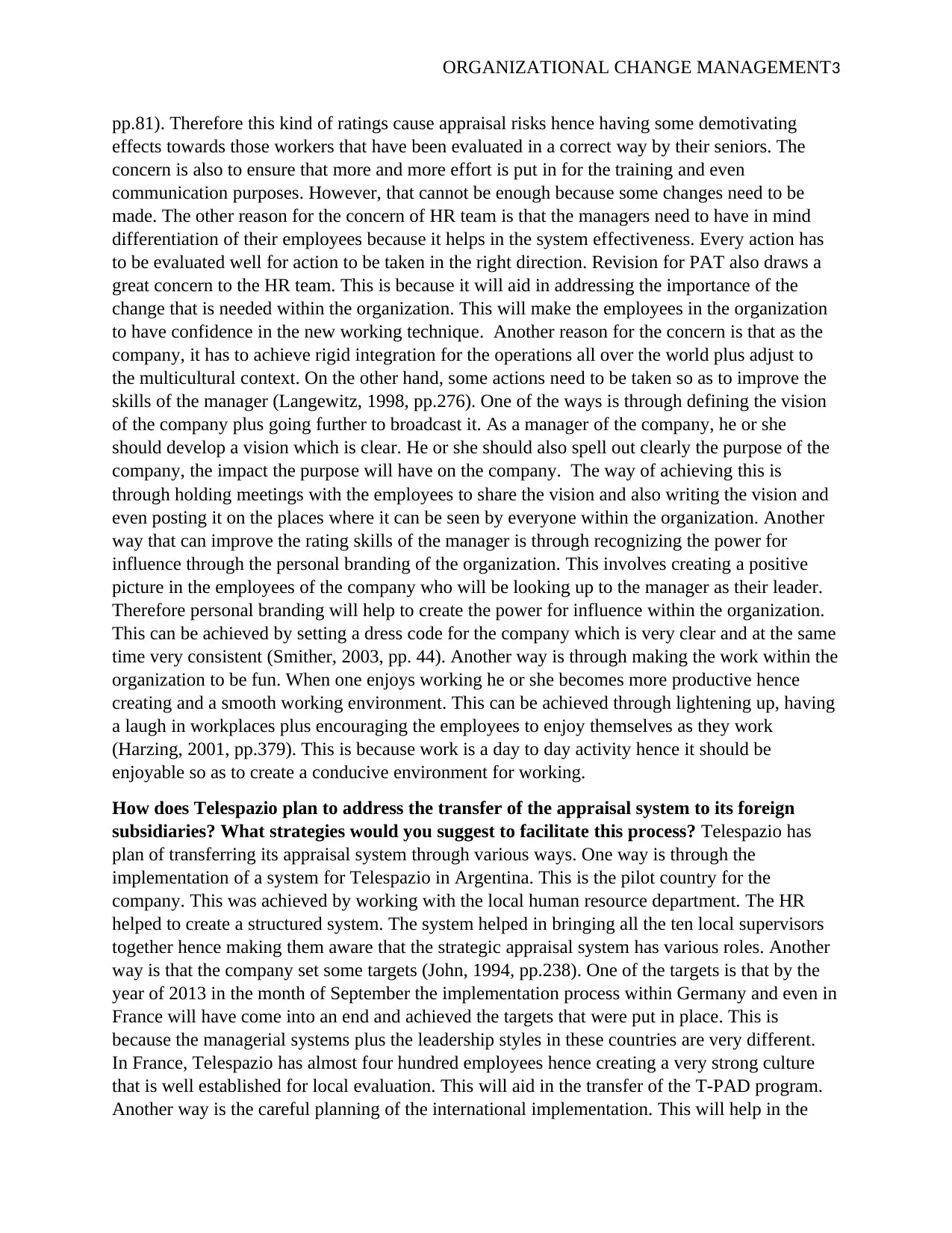
ORGANIZATIONAL CHANGE MANAGEMENT3
pp.81). Therefore this kind of ratings cause appraisal risks hence having some demotivating
effects towards those workers that have been evaluated in a correct way by their seniors. The
concern is also to ensure that more and more effort is put in for the training and even
communication purposes. However, that cannot be enough because some changes need to be
made. The other reason for the concern of HR team is that the managers need to have in mind
differentiation of their employees because it helps in the system effectiveness. Every action has
to be evaluated well for action to be taken in the right direction. Revision for PAT also draws a
great concern to the HR team. This is because it will aid in addressing the importance of the
change that is needed within the organization. This will make the employees in the organization
to have confidence in the new working technique. Another reason for the concern is that as the
company, it has to achieve rigid integration for the operations all over the world plus adjust to
the multicultural context. On the other hand, some actions need to be taken so as to improve the
skills of the manager (Langewitz, 1998, pp.276). One of the ways is through defining the vision
of the company plus going further to broadcast it. As a manager of the company, he or she
should develop a vision which is clear. He or she should also spell out clearly the purpose of the
company, the impact the purpose will have on the company. The way of achieving this is
through holding meetings with the employees to share the vision and also writing the vision and
even posting it on the places where it can be seen by everyone within the organization. Another
way that can improve the rating skills of the manager is through recognizing the power for
influence through the personal branding of the organization. This involves creating a positive
picture in the employees of the company who will be looking up to the manager as their leader.
Therefore personal branding will help to create the power for influence within the organization.
This can be achieved by setting a dress code for the company which is very clear and at the same
time very consistent (Smither, 2003, pp. 44). Another way is through making the work within the
organization to be fun. When one enjoys working he or she becomes more productive hence
creating and a smooth working environment. This can be achieved through lightening up, having
a laugh in workplaces plus encouraging the employees to enjoy themselves as they work
(Harzing, 2001, pp.379). This is because work is a day to day activity hence it should be
enjoyable so as to create a conducive environment for working.
How does Telespazio plan to address the transfer of the appraisal system to its foreign
subsidiaries? What strategies would you suggest to facilitate this process? Telespazio has
plan of transferring its appraisal system through various ways. One way is through the
implementation of a system for Telespazio in Argentina. This is the pilot country for the
company. This was achieved by working with the local human resource department. The HR
helped to create a structured system. The system helped in bringing all the ten local supervisors
together hence making them aware that the strategic appraisal system has various roles. Another
way is that the company set some targets (John, 1994, pp.238). One of the targets is that by the
year of 2013 in the month of September the implementation process within Germany and even in
France will have come into an end and achieved the targets that were put in place. This is
because the managerial systems plus the leadership styles in these countries are very different.
In France, Telespazio has almost four hundred employees hence creating a very strong culture
that is well established for local evaluation. This will aid in the transfer of the T-PAD program.
Another way is the careful planning of the international implementation. This will help in the
pp.81). Therefore this kind of ratings cause appraisal risks hence having some demotivating
effects towards those workers that have been evaluated in a correct way by their seniors. The
concern is also to ensure that more and more effort is put in for the training and even
communication purposes. However, that cannot be enough because some changes need to be
made. The other reason for the concern of HR team is that the managers need to have in mind
differentiation of their employees because it helps in the system effectiveness. Every action has
to be evaluated well for action to be taken in the right direction. Revision for PAT also draws a
great concern to the HR team. This is because it will aid in addressing the importance of the
change that is needed within the organization. This will make the employees in the organization
to have confidence in the new working technique. Another reason for the concern is that as the
company, it has to achieve rigid integration for the operations all over the world plus adjust to
the multicultural context. On the other hand, some actions need to be taken so as to improve the
skills of the manager (Langewitz, 1998, pp.276). One of the ways is through defining the vision
of the company plus going further to broadcast it. As a manager of the company, he or she
should develop a vision which is clear. He or she should also spell out clearly the purpose of the
company, the impact the purpose will have on the company. The way of achieving this is
through holding meetings with the employees to share the vision and also writing the vision and
even posting it on the places where it can be seen by everyone within the organization. Another
way that can improve the rating skills of the manager is through recognizing the power for
influence through the personal branding of the organization. This involves creating a positive
picture in the employees of the company who will be looking up to the manager as their leader.
Therefore personal branding will help to create the power for influence within the organization.
This can be achieved by setting a dress code for the company which is very clear and at the same
time very consistent (Smither, 2003, pp. 44). Another way is through making the work within the
organization to be fun. When one enjoys working he or she becomes more productive hence
creating and a smooth working environment. This can be achieved through lightening up, having
a laugh in workplaces plus encouraging the employees to enjoy themselves as they work
(Harzing, 2001, pp.379). This is because work is a day to day activity hence it should be
enjoyable so as to create a conducive environment for working.
How does Telespazio plan to address the transfer of the appraisal system to its foreign
subsidiaries? What strategies would you suggest to facilitate this process? Telespazio has
plan of transferring its appraisal system through various ways. One way is through the
implementation of a system for Telespazio in Argentina. This is the pilot country for the
company. This was achieved by working with the local human resource department. The HR
helped to create a structured system. The system helped in bringing all the ten local supervisors
together hence making them aware that the strategic appraisal system has various roles. Another
way is that the company set some targets (John, 1994, pp.238). One of the targets is that by the
year of 2013 in the month of September the implementation process within Germany and even in
France will have come into an end and achieved the targets that were put in place. This is
because the managerial systems plus the leadership styles in these countries are very different.
In France, Telespazio has almost four hundred employees hence creating a very strong culture
that is well established for local evaluation. This will aid in the transfer of the T-PAD program.
Another way is the careful planning of the international implementation. This will help in the
⊘ This is a preview!⊘
Do you want full access?
Subscribe today to unlock all pages.

Trusted by 1+ million students worldwide
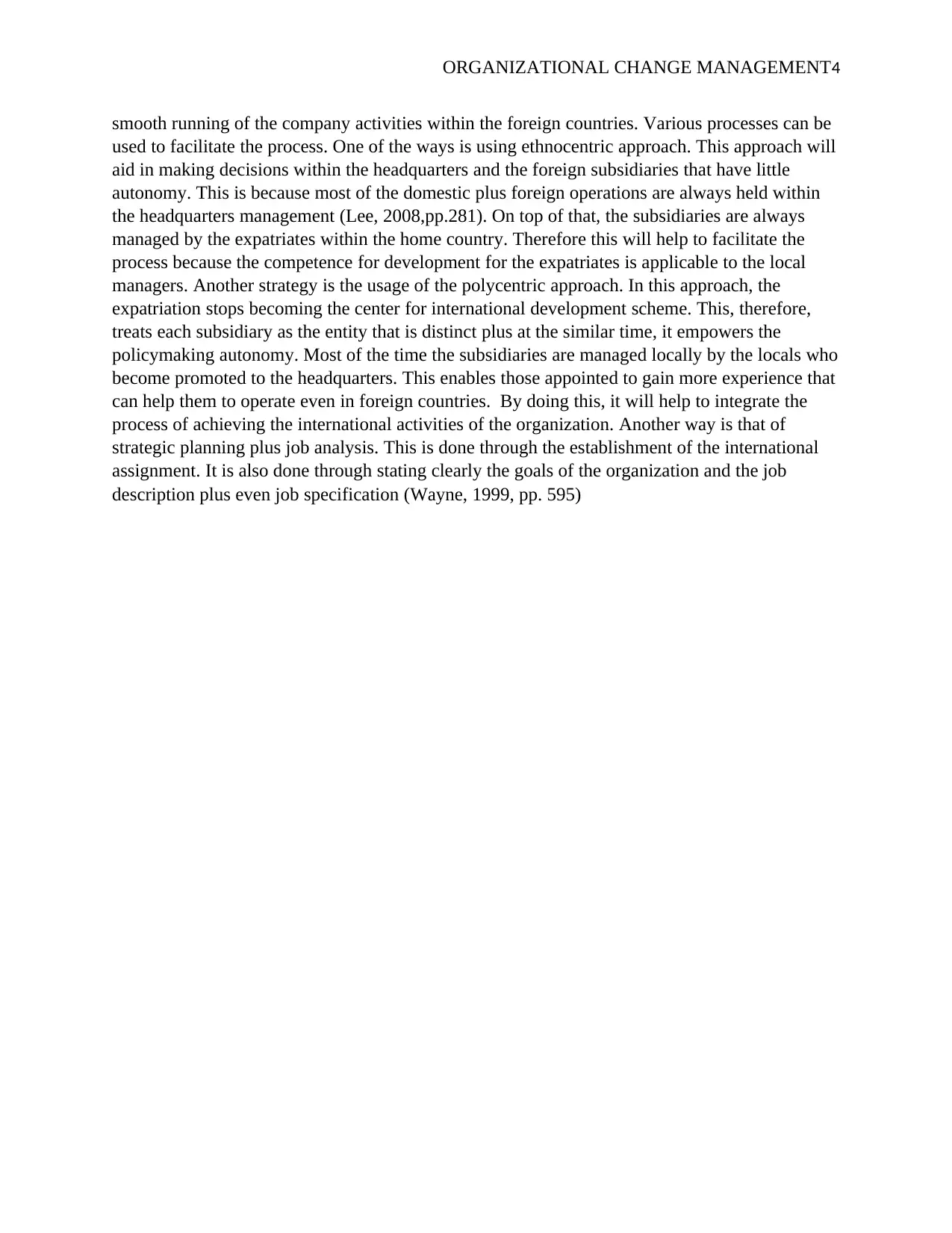
ORGANIZATIONAL CHANGE MANAGEMENT4
smooth running of the company activities within the foreign countries. Various processes can be
used to facilitate the process. One of the ways is using ethnocentric approach. This approach will
aid in making decisions within the headquarters and the foreign subsidiaries that have little
autonomy. This is because most of the domestic plus foreign operations are always held within
the headquarters management (Lee, 2008,pp.281). On top of that, the subsidiaries are always
managed by the expatriates within the home country. Therefore this will help to facilitate the
process because the competence for development for the expatriates is applicable to the local
managers. Another strategy is the usage of the polycentric approach. In this approach, the
expatriation stops becoming the center for international development scheme. This, therefore,
treats each subsidiary as the entity that is distinct plus at the similar time, it empowers the
policymaking autonomy. Most of the time the subsidiaries are managed locally by the locals who
become promoted to the headquarters. This enables those appointed to gain more experience that
can help them to operate even in foreign countries. By doing this, it will help to integrate the
process of achieving the international activities of the organization. Another way is that of
strategic planning plus job analysis. This is done through the establishment of the international
assignment. It is also done through stating clearly the goals of the organization and the job
description plus even job specification (Wayne, 1999, pp. 595)
smooth running of the company activities within the foreign countries. Various processes can be
used to facilitate the process. One of the ways is using ethnocentric approach. This approach will
aid in making decisions within the headquarters and the foreign subsidiaries that have little
autonomy. This is because most of the domestic plus foreign operations are always held within
the headquarters management (Lee, 2008,pp.281). On top of that, the subsidiaries are always
managed by the expatriates within the home country. Therefore this will help to facilitate the
process because the competence for development for the expatriates is applicable to the local
managers. Another strategy is the usage of the polycentric approach. In this approach, the
expatriation stops becoming the center for international development scheme. This, therefore,
treats each subsidiary as the entity that is distinct plus at the similar time, it empowers the
policymaking autonomy. Most of the time the subsidiaries are managed locally by the locals who
become promoted to the headquarters. This enables those appointed to gain more experience that
can help them to operate even in foreign countries. By doing this, it will help to integrate the
process of achieving the international activities of the organization. Another way is that of
strategic planning plus job analysis. This is done through the establishment of the international
assignment. It is also done through stating clearly the goals of the organization and the job
description plus even job specification (Wayne, 1999, pp. 595)
Paraphrase This Document
Need a fresh take? Get an instant paraphrase of this document with our AI Paraphraser
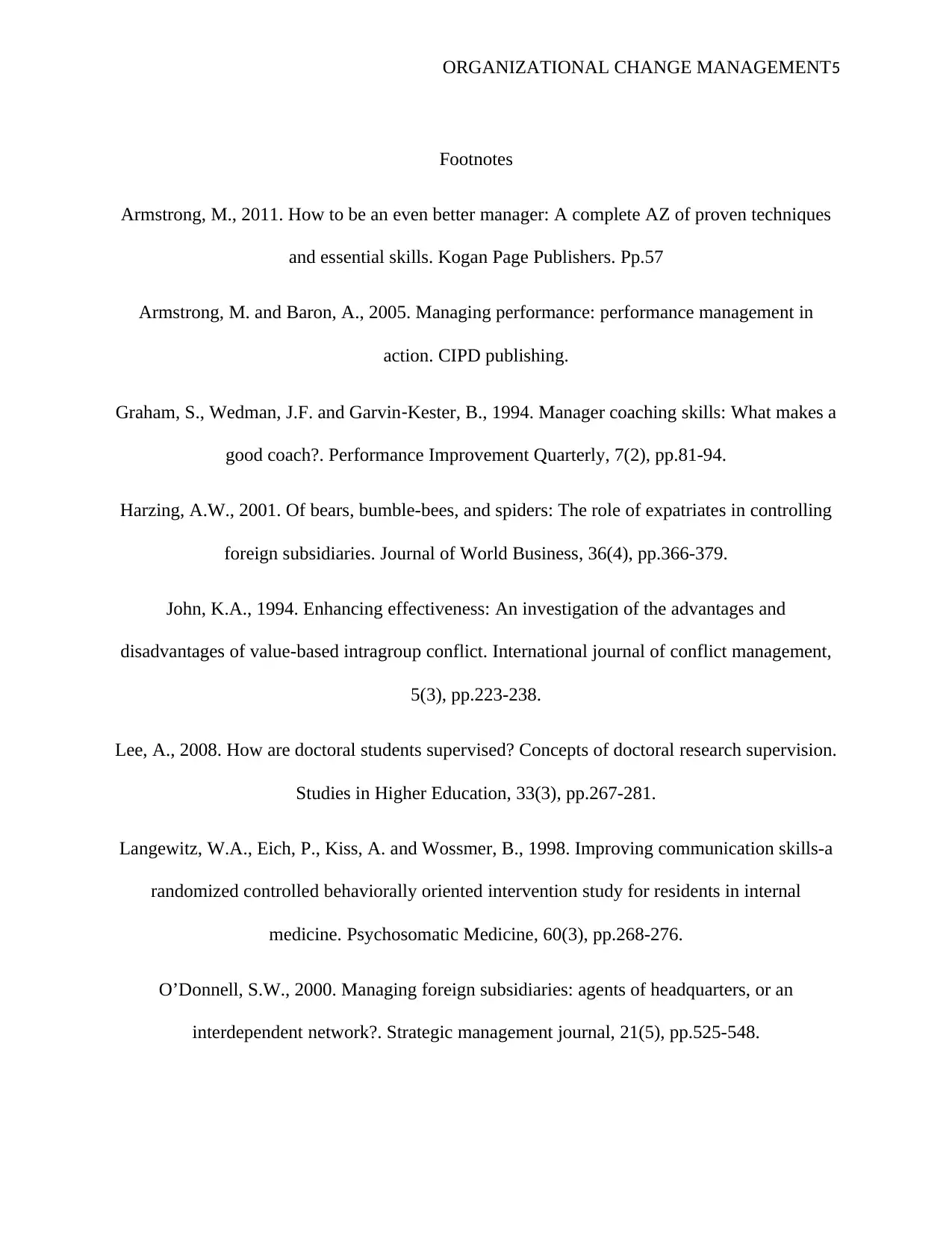
ORGANIZATIONAL CHANGE MANAGEMENT5
Footnotes
Armstrong, M., 2011. How to be an even better manager: A complete AZ of proven techniques
and essential skills. Kogan Page Publishers. Pp.57
Armstrong, M. and Baron, A., 2005. Managing performance: performance management in
action. CIPD publishing.
Graham, S., Wedman, J.F. and Garvin‐Kester, B., 1994. Manager coaching skills: What makes a
good coach?. Performance Improvement Quarterly, 7(2), pp.81-94.
Harzing, A.W., 2001. Of bears, bumble-bees, and spiders: The role of expatriates in controlling
foreign subsidiaries. Journal of World Business, 36(4), pp.366-379.
John, K.A., 1994. Enhancing effectiveness: An investigation of the advantages and
disadvantages of value-based intragroup conflict. International journal of conflict management,
5(3), pp.223-238.
Lee, A., 2008. How are doctoral students supervised? Concepts of doctoral research supervision.
Studies in Higher Education, 33(3), pp.267-281.
Langewitz, W.A., Eich, P., Kiss, A. and Wossmer, B., 1998. Improving communication skills-a
randomized controlled behaviorally oriented intervention study for residents in internal
medicine. Psychosomatic Medicine, 60(3), pp.268-276.
O’Donnell, S.W., 2000. Managing foreign subsidiaries: agents of headquarters, or an
interdependent network?. Strategic management journal, 21(5), pp.525-548.
Footnotes
Armstrong, M., 2011. How to be an even better manager: A complete AZ of proven techniques
and essential skills. Kogan Page Publishers. Pp.57
Armstrong, M. and Baron, A., 2005. Managing performance: performance management in
action. CIPD publishing.
Graham, S., Wedman, J.F. and Garvin‐Kester, B., 1994. Manager coaching skills: What makes a
good coach?. Performance Improvement Quarterly, 7(2), pp.81-94.
Harzing, A.W., 2001. Of bears, bumble-bees, and spiders: The role of expatriates in controlling
foreign subsidiaries. Journal of World Business, 36(4), pp.366-379.
John, K.A., 1994. Enhancing effectiveness: An investigation of the advantages and
disadvantages of value-based intragroup conflict. International journal of conflict management,
5(3), pp.223-238.
Lee, A., 2008. How are doctoral students supervised? Concepts of doctoral research supervision.
Studies in Higher Education, 33(3), pp.267-281.
Langewitz, W.A., Eich, P., Kiss, A. and Wossmer, B., 1998. Improving communication skills-a
randomized controlled behaviorally oriented intervention study for residents in internal
medicine. Psychosomatic Medicine, 60(3), pp.268-276.
O’Donnell, S.W., 2000. Managing foreign subsidiaries: agents of headquarters, or an
interdependent network?. Strategic management journal, 21(5), pp.525-548.
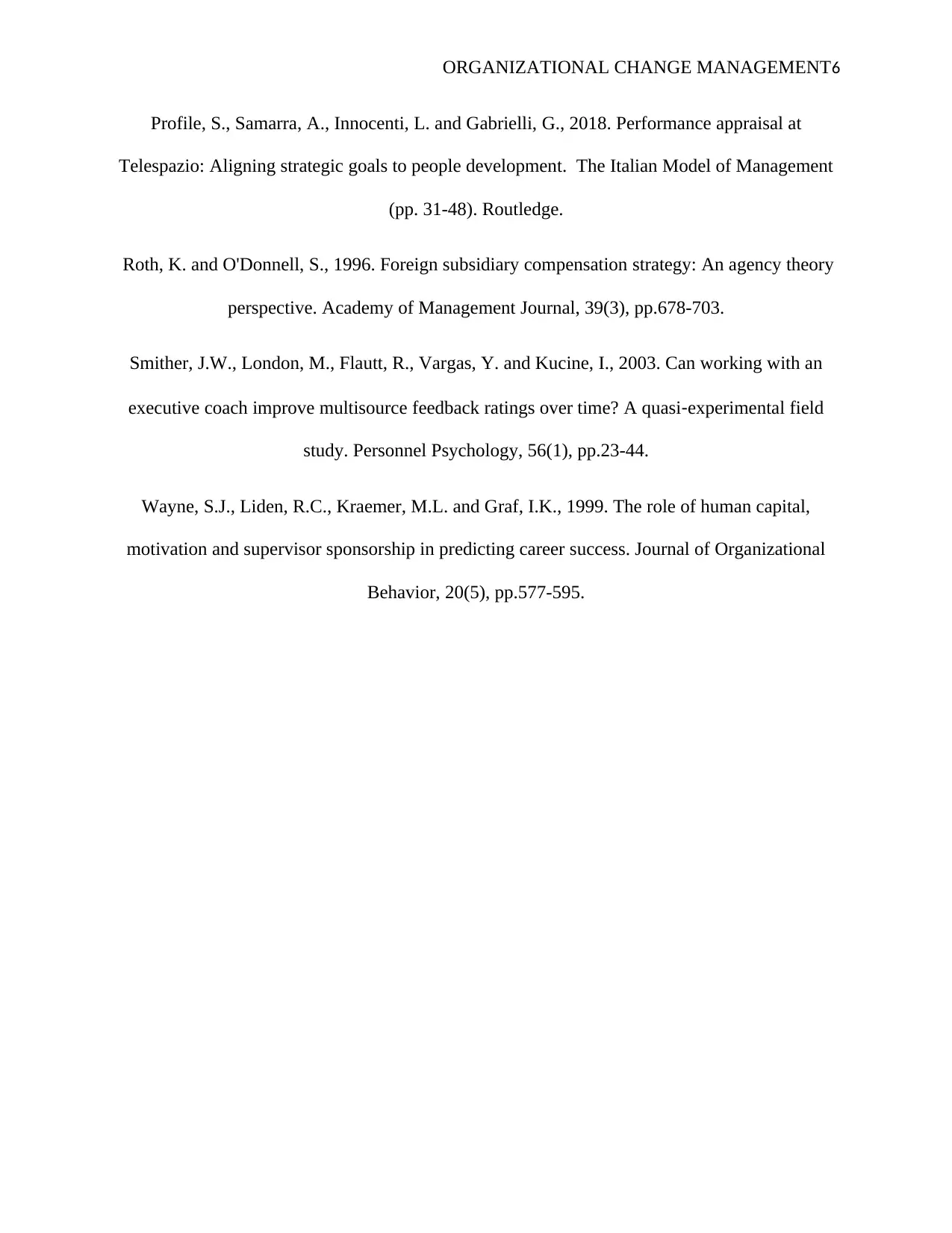
ORGANIZATIONAL CHANGE MANAGEMENT6
Profile, S., Samarra, A., Innocenti, L. and Gabrielli, G., 2018. Performance appraisal at
Telespazio: Aligning strategic goals to people development. The Italian Model of Management
(pp. 31-48). Routledge.
Roth, K. and O'Donnell, S., 1996. Foreign subsidiary compensation strategy: An agency theory
perspective. Academy of Management Journal, 39(3), pp.678-703.
Smither, J.W., London, M., Flautt, R., Vargas, Y. and Kucine, I., 2003. Can working with an
executive coach improve multisource feedback ratings over time? A quasi‐experimental field
study. Personnel Psychology, 56(1), pp.23-44.
Wayne, S.J., Liden, R.C., Kraemer, M.L. and Graf, I.K., 1999. The role of human capital,
motivation and supervisor sponsorship in predicting career success. Journal of Organizational
Behavior, 20(5), pp.577-595.
Profile, S., Samarra, A., Innocenti, L. and Gabrielli, G., 2018. Performance appraisal at
Telespazio: Aligning strategic goals to people development. The Italian Model of Management
(pp. 31-48). Routledge.
Roth, K. and O'Donnell, S., 1996. Foreign subsidiary compensation strategy: An agency theory
perspective. Academy of Management Journal, 39(3), pp.678-703.
Smither, J.W., London, M., Flautt, R., Vargas, Y. and Kucine, I., 2003. Can working with an
executive coach improve multisource feedback ratings over time? A quasi‐experimental field
study. Personnel Psychology, 56(1), pp.23-44.
Wayne, S.J., Liden, R.C., Kraemer, M.L. and Graf, I.K., 1999. The role of human capital,
motivation and supervisor sponsorship in predicting career success. Journal of Organizational
Behavior, 20(5), pp.577-595.
⊘ This is a preview!⊘
Do you want full access?
Subscribe today to unlock all pages.

Trusted by 1+ million students worldwide
1 out of 6
Related Documents
Your All-in-One AI-Powered Toolkit for Academic Success.
+13062052269
info@desklib.com
Available 24*7 on WhatsApp / Email
![[object Object]](/_next/static/media/star-bottom.7253800d.svg)
Unlock your academic potential
Copyright © 2020–2025 A2Z Services. All Rights Reserved. Developed and managed by ZUCOL.




